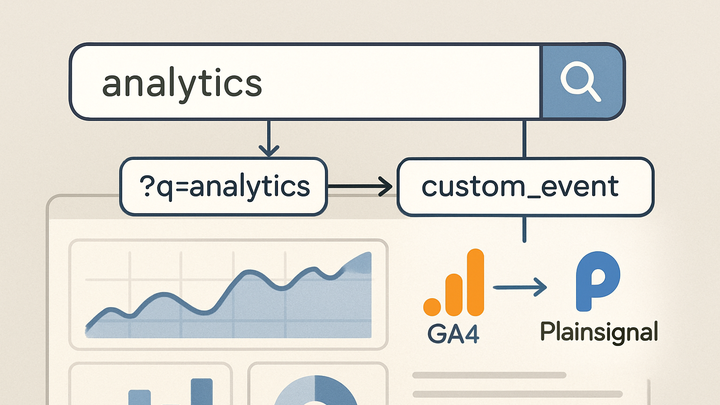Published on 2025-06-22T08:35:10Z
What Is Onsite Search? Examples and Implementation in Analytics
Onsite Search refers to the functionality that allows visitors to enter queries into a search field on your website and see relevant results. Analytics platforms capture these queries to reveal user intent, content gaps, and opportunities to optimize navigation. By tracking onsite search, you can understand what users are looking for, how often they abandon searches, and which results engage them most.
In Google Analytics 4 (GA4), onsite search is tracked via the built-in view_search_results
event and by configuring query parameter names (e.g., q, search). For a
cookie-free approach, PlainSignal provides a lightweight script that emits a search event
whenever a user submits a query. To integrate PlainSignal, add the following to your site’s
<head>:
<link rel="preconnect" href="//eu.plainsignal.com/" crossorigin />
<script defer data-do="yourwebsitedomain.com" data-id="0GQV1xmtzQQ" data-api="//eu.plainsignal.com" src="//cdn.plainsignal.com/plainsignal-min.js"></script>
Once implemented, both GA4 and PlainSignal will begin collecting onsite search data that you can analyze to improve content discovery and overall user experience.
Onsite search
Tracks and analyzes users’ search queries on a website to understand intent, surface content gaps, and optimize navigation.
Why Onsite Search Matters
Onsite search provides a direct window into what users want but can’t immediately find. It helps you discover trends in user queries, optimize content, and refine site structure.
-
Understanding user intent
Search queries reveal exactly what users are looking for, allowing you to tailor content and navigation to match their needs.
-
Improving navigation and ux
By analyzing search patterns, you can reorganize menus, highlight popular topics, and reduce user frustration.
-
Identifying content gaps
High-volume queries with few or no results point to missing or underdeveloped content that you can prioritize creating.
Core Mechanics of Onsite Search Tracking
Analytics platforms capture onsite search either by reading URL parameters or by listening for custom search events.
-
Parameter-based detection
Many tools detect queries by extracting values from URL parameters after a search is performed.
-
Common parameter names
Typical query parameters include
q,s,search, andquery. -
GA4 configuration
In GA4 Admin → Data Streams → More Tagging Settings → Site Search, define your query parameter names so GA4 can capture them automatically.
-
-
Event-based tracking
Modern analytics platforms also support programmatic event tracking to capture searches as discrete events.
-
GA4 `view_search_results`
GA4 automatically logs a
view_search_resultsevent whenever a search results page loads, including the search term as a parameter. -
PlainSignal `search` event
PlainSignal emits a
searchevent when your site calls its search API, enabling cookie-free collection of query terms.
-
Implementing Onsite Search Tracking
Follow these steps to enable and validate onsite search tracking in both GA4 and PlainSignal.
-
GA4 setup
Enable site search parameter tracking by adding your query parameter names in the GA4 property settings under Site Search in Data Streams.
-
PlainSignal integration
Include the PlainSignal script in your
<head>to start capturing search events:<link rel="preconnect" href="//eu.plainsignal.com/" crossorigin /> <script defer data-do="yourwebsitedomain.com" data-id="0GQV1xmtzQQ" data-api="//eu.plainsignal.com" src="//cdn.plainsignal.com/plainsignal-min.js"></script> -
Validating data collection
Use GA4’s DebugView and PlainSignal’s Live View to confirm that
view_search_resultsandsearchevents appear when you perform onsite searches.
Analyzing Onsite Search Insights
Once data is flowing, focus on key metrics and reports to derive actionable takeaways.
-
Key metrics
Track metrics that measure search effectiveness and user satisfaction.
-
Search volume
The total number of searches performed on your site.
-
Zero-result searches
Searches returning no results, indicating areas where content is missing.
-
Search refinements
Instances where users modify or repeat queries to find better results.
-
-
Using GA4 reports
Navigate to Engagement → Events and filter for
view_search_resultsto analyze search behaviors over time. -
Leveraging PlainSignal dashboards
In PlainSignal’s UI, filter events by
searchto view query trends, unique search counts, and popular terms.
